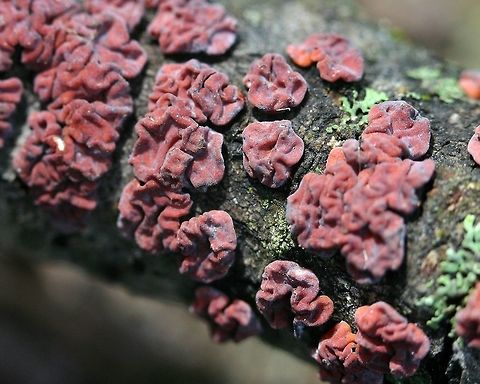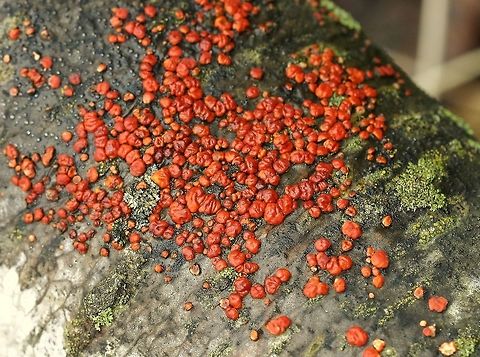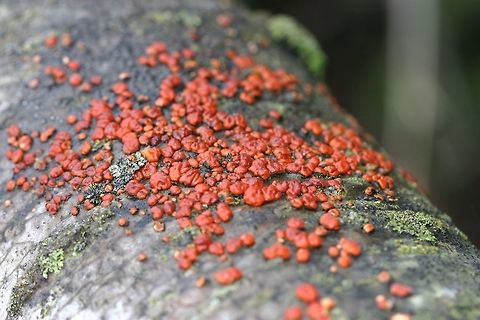
Appearance
Fruiting Body: Resupinate; usually growing in patches of cushion-shaped individual fruiting bodies measuring up to about 1 cm across and 2 mm high; surface waxy, wrinkled, red to orange-red when fresh (sometimes with a whitish dusting), becoming purplish with age.Flesh: Hard; whitish to grayish.
Spore Print: White.
Microscopic Features: Spores 6-9 x 2-3 µ; smooth; cylindrical to sausage-shaped; inamyloid. Basidia 4-sterigmate. Gloeocystidia pear-shaped to clavate; 10-25 µ across. Cystidia cylindric to fusiform; scarcely projecting; 5-8 µ wide; with encrusted apices. Hyphal system monomitic. Clamp connections present.

Naming
Peniophora rufa (Fr.) Boidin, Bulletin de la Société Mycologique de France 74 (4): 443 (1959)Thelephora rufa Fr., Elenchus Fungorum 1: 187 (1828)
Xerocarpus rufus (Fr.) P. Karst., Bidrag till Kännedom av Finlands Natur och Folk 37: 135 (1882)
Sterellum rufum (Fr.) J. Erikss., Symbolae Botanicae Upsalienses 16 (1): 120 (1958)
Tubercularia pezizoidea Schwein., Transactions of the American Philosophical Society 4 (2): 301 (1832)
Hypocrea richardsonii Vestergr., Micr. rar. sel. 404 (1867)
Habitat
Saprobic and apparently sometimes pathogenic on the wood of aspens (quaking aspen and big-toothed aspen), and occasionally on the wood of other hardwoods; erupting through the still-attached bark; spring, summer, and fall; fairly widely distributed where the host trees are present (northern and montane North America).References:
Some text fragments are auto parsed from Wikipedia.
https://www.mushroomexpert.com/peniophora_rufa.htmlhttp://www.mycobank.org/Biolomics.aspx?Table=Mycobank&MycoBankNr_=282802
https://en.wikipedia.org/wiki/Peniophora
http://mycoportal.org/portal/taxa/index.php?taxauthid=1&taxon=357010&cl=81
http://mycoportal.org/portal/map/googlemap.php?maptype=taxa&taxon=357010&clid=81
